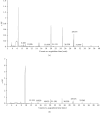Inhibition of α-Amylase and α-Glucosidase Using Baccaurea ramiflora
- PMID: 40551810
- PMCID: PMC12185207
- DOI: 10.1155/sci5/8768659
Inhibition of α-Amylase and α-Glucosidase Using Baccaurea ramiflora
Abstract
The hunt for alternative antidiabetic treatments that result in fewer side effects judged against established treatments is being powered by the mounting worldwide pervasiveness of diabetes mellitus. Playing a critical role in many biological processes, Baccaurea ramiflora, a long-established medicinal plant commonly used throughout Southeast Asia, presents abundant health benefits. An assessment of the various ethanol extracts from B. ramiflora drawn from the leaves, stems, stem bark, peel, and flesh with seed revealed the total phenolic and flavonoid contents in addition to the levels of inhibitory activity against the enzymes α-amylase and α-glucosidase. In the case of total phenolic and flavonoids contents, the findings confirmed that the leaves, flesh with seed, and peel extracts were the richest source of phenolics. The leaf extract showed higher flavonoid content than others. The greatest levels of inhibitory activity against the two enzymes of interest were exhibited by the flesh with seed and peel: the respective IC50 values associated with α-amylase and α-glucosidase were 0.50 ± 0.03 and 0.69 ± 0.01 mg mL-1 for flesh with seed, and 0.61 ± 0.04 and 0.59 ± 0.01 mg mL-1 for peel. The various extracts were all capable of inhibiting enzyme activity in a concentration-dependent manner. GC-MS analysis of the flesh with seed extract identified phenol, 3,5-bis(1,1-dimethylethyl)-, dimethylsulfoxonium formylmethylide, methyl salicylate, and other compounds. Additionally, the major compounds present in the peel extract were 2,4-di-tert-butylphenol, dimethyl sulfone, cyclooctasiloxane, hexadecamethyl, and other compounds. From these findings, B. ramiflora offers potential for use in the field of nutraceuticals and functional foods and might also find application in treating health conditions such as diabetes.
Keywords: Baccaurea ramiflora extracts; diabetes; α-amylase; α-glucosidase.
Copyright © 2025 Pongsathorn Klomsakul and Pornchanok Chalopagorn. Scientifica published by John Wiley & Sons Ltd.
Conflict of interest statement
The authors declare no conflicts of interest.
Figures
Similar articles
-
Systemic pharmacological treatments for chronic plaque psoriasis: a network meta-analysis.Cochrane Database Syst Rev. 2021 Apr 19;4(4):CD011535. doi: 10.1002/14651858.CD011535.pub4. Cochrane Database Syst Rev. 2021. Update in: Cochrane Database Syst Rev. 2022 May 23;5:CD011535. doi: 10.1002/14651858.CD011535.pub5. PMID: 33871055 Free PMC article. Updated.
-
Phenolic compounds, antioxidant and α-glucosidase inhibitory activities from moringa oleifera seed by-products.Sci Rep. 2025 Jul 2;15(1):22878. doi: 10.1038/s41598-025-06916-8. Sci Rep. 2025. PMID: 40596503 Free PMC article.
-
Sertindole for schizophrenia.Cochrane Database Syst Rev. 2005 Jul 20;2005(3):CD001715. doi: 10.1002/14651858.CD001715.pub2. Cochrane Database Syst Rev. 2005. PMID: 16034864 Free PMC article.
-
Systemic pharmacological treatments for chronic plaque psoriasis: a network meta-analysis.Cochrane Database Syst Rev. 2017 Dec 22;12(12):CD011535. doi: 10.1002/14651858.CD011535.pub2. Cochrane Database Syst Rev. 2017. Update in: Cochrane Database Syst Rev. 2020 Jan 9;1:CD011535. doi: 10.1002/14651858.CD011535.pub3. PMID: 29271481 Free PMC article. Updated.
-
First comprehensive compositional analysis of E. arborescens leaves with new insights into their potential as enzyme inhibitors.Sci Rep. 2025 Jul 30;15(1):27784. doi: 10.1038/s41598-025-96266-2. Sci Rep. 2025. PMID: 40739322 Free PMC article.
References
-
- International Diabetes Federation. IDF Diabetes Atlas . International Diabetes Federation; 2021.
-
- Etxeberria U., de la Garza A. L., Campión J., Martínez J. A., Milagro F. I. Antidiabetic Effects of Natural Plant Extracts via Inhibition of Carbohydrate Hydrolysis Enzymes With Emphasis on Pancreatic Alpha Amylase. Expert Opinion on Therapeutic Targets . 2012;16(3):269–297. doi: 10.1517/14728222.2012.664134. - DOI - PubMed
LinkOut - more resources
Full Text Sources
Miscellaneous


